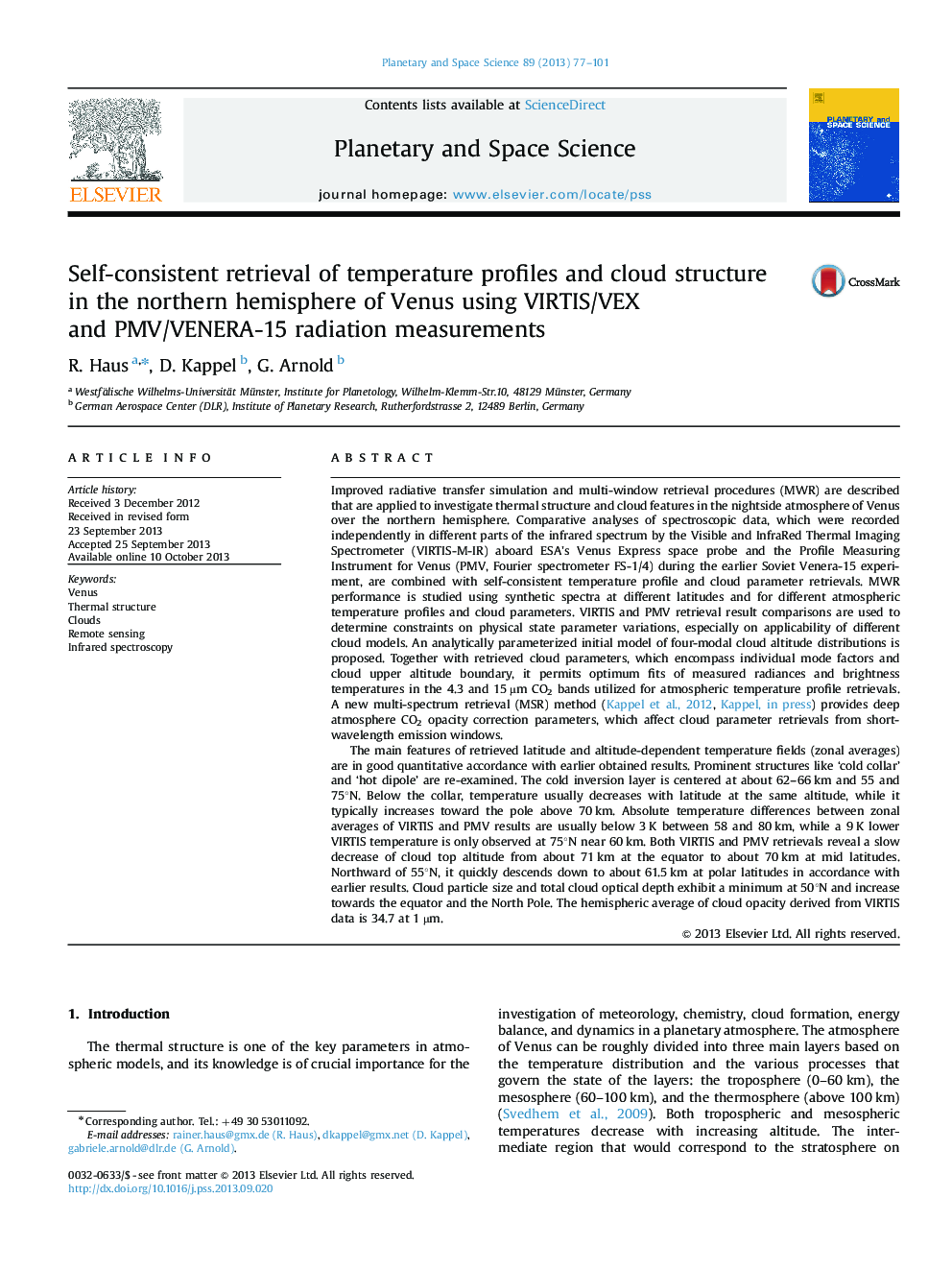| کد مقاله | کد نشریه | سال انتشار | مقاله انگلیسی | نسخه تمام متن |
|---|---|---|---|---|
| 1781237 | 1523947 | 2013 | 25 صفحه PDF | دانلود رایگان |

• Self-consistent temperature profile and cloud parameter retrievals are performed.
• Comparative VIRTIS and PMV data analyses yield constraints on atmospheric features.
• An updated zonal average temperature map of the northern hemisphere is presented.
• Cloud top altitude decreases from 71 km at low/mid-latitudes to 61.5 km at the pole.
• Venus' cloud particle size increases from mid-latitudes towards the North Pole.
Improved radiative transfer simulation and multi-window retrieval procedures (MWR) are described that are applied to investigate thermal structure and cloud features in the nightside atmosphere of Venus over the northern hemisphere. Comparative analyses of spectroscopic data, which were recorded independently in different parts of the infrared spectrum by the Visible and InfraRed Thermal Imaging Spectrometer (VIRTIS-M-IR) aboard ESA's Venus Express space probe and the Profile Measuring Instrument for Venus (PMV, Fourier spectrometer FS-1/4) during the earlier Soviet Venera-15 experiment, are combined with self-consistent temperature profile and cloud parameter retrievals. MWR performance is studied using synthetic spectra at different latitudes and for different atmospheric temperature profiles and cloud parameters. VIRTIS and PMV retrieval result comparisons are used to determine constraints on physical state parameter variations, especially on applicability of different cloud models. An analytically parameterized initial model of four-modal cloud altitude distributions is proposed. Together with retrieved cloud parameters, which encompass individual mode factors and cloud upper altitude boundary, it permits optimum fits of measured radiances and brightness temperatures in the 4.3 and 15 µm CO2 bands utilized for atmospheric temperature profile retrievals. A new multi-spectrum retrieval (MSR) method (Kappel et al., 2012 and 1) provides deep atmosphere CO2 opacity correction parameters, which affect cloud parameter retrievals from short-wavelength emission windows.The main features of retrieved latitude and altitude-dependent temperature fields (zonal averages) are in good quantitative accordance with earlier obtained results. Prominent structures like ‘cold collar’ and ‘hot dipole’ are re-examined. The cold inversion layer is centered at about 62–66 km and 55 and 75°N. Below the collar, temperature usually decreases with latitude at the same altitude, while it typically increases toward the pole above 70 km. Absolute temperature differences between zonal averages of VIRTIS and PMV results are usually below 3 K between 58 and 80 km, while a 9 K lower VIRTIS temperature is only observed at 75°N near 60 km. Both VIRTIS and PMV retrievals reveal a slow decrease of cloud top altitude from about 71 km at the equator to about 70 km at mid latitudes. Northward of 55°N, it quickly descends down to about 61.5 km at polar latitudes in accordance with earlier results. Cloud particle size and total cloud optical depth exhibit a minimum at 50°N and increase towards the equator and the North Pole. The hemispheric average of cloud opacity derived from VIRTIS data is 34.7 at 1 µm.
Journal: Planetary and Space Science - Volume 89, December 2013, Pages 77–101